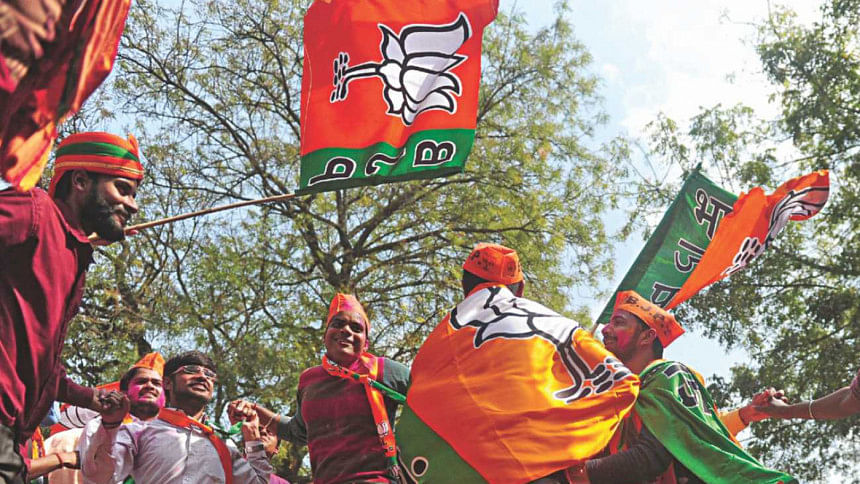The saffron wave returns

The Indian Election Commission on March 11, 2017 announced the results of five State Assembly elections. BJP swept the election in Uttar Pradesh (UP), winning 312 seats in the 403-seat assembly. BJP's vote share jumped from 15 percent in 2012 to 39.6 percent this time, securing three-fourth majority in the assembly. The party also gained a majority in Uttarakhand, obtaining 57 seats in a 70-seat assembly.
Uttar Pradesh's politics is extremely complicated, not only because of its backwardness and violence, but also because of stratified Hindu castes, OBCs, Dalits, and the largest Muslim population in India.
BJP ran the campaign without naming the prospective Chief Minister. After such a massive mandate while keeping an eye on 2019, the BJP wants someone senior as Chief Minister, who is in sync with the RSS but has appeal to all communities. Several names are in circulation and the swearing-in ceremony will be held on March 19 in Lucknow.
As in 2014, this was 'voter-catcher' Modi's victory rather than a BJP win. Though the BJP has not delivered on its promises of development, people surprisingly believed Modi's invectives. Modi campaigned against young CM Akhilesh Yadav, raising a whirlwind of 21 rallies in the seven-phase UP election. All BJP stalwarts plunged into UP long before the election. BJP's president Amit Shah put together a well-oiled RSS cadre-based election machinery which delivered.
In this triangular election battle, BJP had advantages over SP and BSP in terms of manpower and money. BJP's "Hindutva" slogan was made more inclusive to include "non-Brahminical" segments of Hindus, and consolidated the communal Hindu vote-bank. BJP also played skillfully with the caste-based vote banks, focusing on upper caste Hindus, Jats in western UP, non-Yadav OBCs, and non-Jatav Dalits. Modi also cleverly exploited demonetisation as a poor vs rich class issue. He explained that poor people were not affected as they did not hold large denomination notes. The corrupt people of the richer strata, he claimed, would be caught and their illegal wealth would be used for the development of the poor.
Surprisingly, though UP has 40 million Muslims, BJP did not field a single Muslim candidate. Muslims were ignored as, in BJP's view, they would not vote for the party anyway. Mayawati's BSP fielded 99 Muslim candidates and Samajwadi Party gave tickets to 56 Muslim candidates. Naturally, most of the Muslim votes went to SP and BSP. This time only 24 Muslims were elected as MLAs compared to 68 in 2012.
The SP-Congress coalition managed only 54 seats, while BSP got 19. The anti-incumbency factor worked against the Akhilesh-Rahul duo ('UP ke ladke'). Besides, Akhilesh's revolt against his father Mulayam Singh Jadav did not go down well with the older generations. Mulayam also was passive in campaigning. Now the SP could actually be staring at the possibility of a split. Mayawati lost out because the BJP stole her vote-banks.
In Punjab, Congress swept in with 77 seats in the 117-seat Assembly. Opinion polls indicated that the Aam Aadmi Party would get majority, but Arvind Kejriwal had to be satisfied with 20 seats. BJP lost miserably and managed only three seats, while outgoing Shiromani Akali Dal got 15 seats. The victory in Punjab means Congress is yet to be written off from Indian politics.
BJP turned Goa and Manipur into its bastion by forming governments, despite being second in polls. BJP, immediately after the results, lured the regional parties and independent MLAs to form coalitions in both states. In Manipur, BJP got 21 seats, while Congress picked 28 in the 60-seat parliament. In Goa, BJP got 13 seats and Congress 17 in the 40-seat Assembly. In Manipur, Biren Singh, once a Congress leader, has been sworn-in as the Chief Minister representing BJP, and Defense Minister Manohar Parrikar has become Chief Minister of Goa. These developments unleashed a bitter quarrel between BJP and Congress. Parrikar has already proved his majority with 22 votes. Congress has alleged that BJP had offered huge sums of money to the smaller parties in Goa and Manipur to form a majority. An outsider, however, could view this as a case of BJP outwitting Congress because it was caught napping.
BJP's victory is a sad development for the regional parties – particularly, the SP and BSP – which have been planning to put up a joint platform along with other regional parties against BJP in the 2019 Lok Sabha elections. The voting pattern this time indicates that people were not impressed by the secular politics offered by the regional parties. Regional parties will have to stop bickering and move towards an inclusive and progressive narrative if they want to challenge BJP in 2019. As for Congress, it has failed to capitalise on its gains. It has to reinvent itself if it wants to be relevant in 2019.
This round of state elections was a mid-term referendum for Modi. The Modi-cult has passed the test with flying colours, firmly establishing BJP as an all-India political outfit. BJP now dominates 18 out of 29 states. This will significantly increase its tally in the Rajya Sabha, where it is currently a minority. BJP requires the majority not only to have its own candidate for presidency in July, when Pranab Mukherjee retires, but also to push legislation without opposition from Rajya Sabha.
BJP's victory in these elections has manifold ramifications for India. It is good that Indians have a strong leader in Narendra Modi. Will Modi's populist slogans like "Sabka sath sabka vikas" (collective effort, inclusive growth) and "achey din" (good days ahead) lead to a majoritarian style of democracy, when minority communities (for example, Muslims and Dalits) remain marginalised? What about India's neighbours? Will Modi reset relations with neighbouring countries?
After setbacks in 2016, the saffron wave is back with the slogan "New India by 2022", setting the ground to win a second term in 2019.
The writer is former Ambassador and Secretary.

 For all latest news, follow The Daily Star's Google News channel.
For all latest news, follow The Daily Star's Google News channel. 



Comments